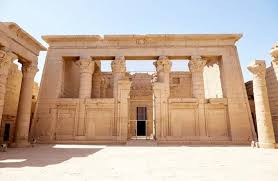Kalabsha Temple is one of Aswan’s most serene and impressive ancient monuments, located on the western bank of the Nile near the modern Aswan High Dam. Originally constructed around 30 BCE during the early Roman era under Emperor Augustus, this temple was dedicated to Mandulis, the Nubian sun god. Its unique artistic fusion of Egyptian and Roman styles marks it as one of Nubia’s grandest well-preserved temples.
History of Kalabsha Temple
Built during the late Ptolemaic period and completed under Roman rule, Kalabsha Temple stands on the site of an earlier sanctuary from Egypt’s 18th Dynasty, linked to Pharaohs like Amenhotep II. It was never fully completed, but the existing reliefs show intricate depictions of gods, pharaohs, and rituals. The temple’s walls also record historical inscriptions, including one forbidding pigs within the temple, and another commemorating Nubian King Silko’s victories.
In the 1960s, to save it from flooding caused by the construction of the Aswan High Dam, the temple was carefully dismantled and relocated to its present position on New Kalabsha Island. This remarkable engineering feat preserved one of Nubia’s finest architectural treasures.
Location and Why It’s Named Kalabsha Temple
Situated about 50 kilometers south of Aswan, near the shores of Lake Nasser, the temple was originally on Kalabsha Island. The name “Kalabsha” references the locality and stems from Nubian roots connected to the area’s rich cultural legacy. Today’s temple resides on New Kalabsha Island, accessible to visitors wishing to explore Nubia’s heritage away from the crowded tourist paths.
Purpose of the Temple
The temple was primarily built to honor Mandulis, a Nubian solar deity revered for protection and fertility. Additionally, the temple included shrines dedicated to the Egyptian gods Isis and Osiris, reflecting the cultural amalgamation of Nubian and Egyptian religious beliefs. It served as a place of worship, ritual, and community gathering for both ancient Nubians and Egyptians.
Interior Layout
Kalabsha Temple follows classical Ptolemaic temple architecture, featuring:
- A monumental gateway (pylon) leading into an open-air forecourt.
- A vast colonnaded or hypostyle hall adorned with slender columns and intricate reliefs.
- Two transversal chambers used as offering halls.
- A sanctuary housing the cult image of Mandulis.
- Additional chapels, including one dedicated to the Nubian god Dedwen, reflect the temple’s religious complexity.
The temple’s architecture showcases a blend of Egyptian tradition with Greco-Roman elements, evident in its column styles and spatial arrangements. Visitors can also climb a staircase from the sanctuary to the temple roof, offering stunning views of the temple and the serene lake.
Fascinating Facts
- The temple walls feature Meroitic and Greek inscriptions illustrating Nubia’s multicultural history.
- Crosses carved into the stone signify the temple’s later use as a Christian church.
- Kalabsha Temple was the largest free-standing temple relocated to save it from flooding caused by the Aswan High Dam, a UNESCO World Heritage initiative.
Conclusion
Kalabsha Temple stands as a tranquil monument embodying the spiritual and architectural brilliance of Nubia, preserved against natural threats by modern engineering. Visitors to Aswan can explore its peaceful courtyards and richly decorated halls to connect with a layered history that spans ancient Egypt, Nubia, Rome, and early Christianity.



